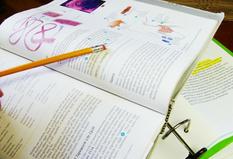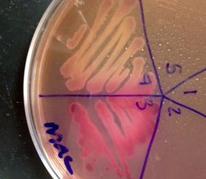 | ||||
Microbial Metabolism
Review Questions
Virtual Microbiology Classroom of Science Prof Online
Microbial Metabolism Review Questions
These multiple choice and true/false questions are designed to help students practice and test their understanding of is topic.
SPO VIRTUAL CLASSROOMS
 | ||||||
MacConkey's Agar with lactose negative Salmonella on top (colorless) and Lac + E. coli on bottom (hot pink).
2. Specifically which subpathways of aerobic cellular respiration produce the carbon dioxide that you exhale?
3. What is a proton gradient and specifically what is its role in cellular respiration?
4. What effect would the absence of oxygen have on the reactions of the electron transport chain?
5. Explain the difference between anabolic and catabolic reactions and give an example of each.
6. Explain how oxidation-reduction reactions relate to cellular respiration.
7. What action results in the phosphoylation of ADP in the electron transport chain? (i.e. What is required for a molecule of ADP to change into ATP? The answer is not " just add a phospate".)
1. Into which molecules is most of the energy of Kreb's Cycle's redox reactions transferred? How will these molecules convert their energy to a form that can be used to make ATP?
Page last updated 1/2015
These are review questions from the Virtual Microbiology Classrooms (8-week & 16-week), designed to help students better understand the history of microbiology. They are based on materials that can be found on the Microbial Metabolism Lecture Main Page.
Virtual Microbiology Classroom provides a wide range of free educational resources including PowerPoint Lectures, Study Guides, Review Questions and Practice Test Questions.
Page last updated: 2/2016
8. What are the main stages of aerobic respiration? What important materials go into and come out of each stage of this process (please list specifically for each of the main stages)?
9. What are the 3 key things that have to happen in the electron transport chain in order to produce ATP (the answer relates to electrons and hydrogen ions).
10. Compare and contrast aerobic respiration, anaerobic respiration and fermentation. (In order to answer this you must define each and then point out the differences.)
11. How many ATP are produced during fermentation of one glucose molecule? During what specific process is the ATP produced?
12. Why do we inhale oxygen and exhale carbon dioxide (please give your answer in terms of the reactions of aerobic respiration that we studied).
13. How does metabolism relate to how differential media provide information on a microbes identity. Specifically explain how metabolism relates to the information that MacConkey's agar and Mannitol Salt agar give us.
14. How does microbial metabolism relate to identification of bacteria using the API-20E? You’ll need to explain how the API-20E works and how this relates to the unknown organism’s metabolic capabilities.




